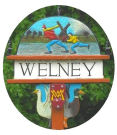
The Welney Website
Churches & Chapels in Welney past and present
page created Jan 2011, amended/updated Wednesday, 19 June 2013
Introduction
At the bottom of this page is a table of churches and chapels within or adjacent to Welney. But first a brief explanation of English Parishes, and how their roles and areas have changed.Parishes from early times up to the 20th Century
In England a parish was an area based largely on the lands of a 'manor', described by the eminent judge Lord Denning thus:"In mediæval times the manor was the nucleus of English rural life. It was an administrative unit of an extensive area of land. The whole of it was owned originally by the lord of the manor. He lived in the big house called the manor house. Attached to it were many acres of grassland and woodlands called the park. These were the “demesne lands” which were for the personal use of the lord of the manor. Dotted all round were the enclosed homes and land occupied by the “tenants of the manor”. (Quotation taken from Wikipaedia)Parishes may therefore have crossed county borders, and often did.
The Lord of the Manor, sometimes called 'the Squire' was wealthy and powerful, usually the main employer, landlord and arbiter in local disputes. Within the parish was a Church under the jurisdiction of a Parish Priest, and the Church and Priest were often financed or maintained by the Lord or Squire.
In large rural areas smaller churches or chapels administered by junior priests (often called curates) served outlying or remote parts of the Parish. This was the case with Welney which was a 'chapelry' within the parish of Upwell until 1862 when it was granted full parish status.
Parishes from the 20th Century
At the end of the 19th century another kind of parish evolved, the 'civil' parish, the lowest tier of local government, controlled by a Parish Council elected by parishioners. Civil parishes are divisions of counties, and therefore have different boundaries to the original manor-based parish which remained simply as 'eclisiastical' (church-based) parishes, divisions of a diocese within the Church of England.The two completely different types of Parish often have or had the same name and it can sometimes be difficult to determine in records which is being referred to; I hope the above may assist, but remember it is only an extremely short over-view by a layman of an enormous and complex subject.
back to contents
| If you've visited this page before you may need to "refesh" the page to see the latest version by clicking the browser reload button |
Denominations
England is a Christian country. For a thousand years the predominate faith was Roman Catholic until the 16th century when the protestant reformation led to a spilt with Rome, and the establishment of the Church of England as the official state religion, becoming leader of the worldwide Anglican Communion.Church of England (C of E)
In an English eclesiastical parish the main church is that of the established protestant Anglican state church, the Church of England.Many English villages also have, or had, smaller churches or chapels to serve other Christian denominations particularly "nonconformists".
Nonconformist
Nonconformist is the term used in England to describe protestant Christians who do not accept the practices, beliefs and legal requirements of the 'established' church. It covers many differing groups and sub-groups or branches, including:- Presbyterians
- Congregationalists
- Methodists
- Wesleyan
- Calvinist
- Primitive
- United
- Unitarians
- Baptists
- Zionist Baptists
Nonconformity was very strongly established in the middle of the 19th century and congregations at the parish churches in this area were often only between a quarter and a third of the total number of church-goers. Locally there were five nonconformist chapels serving the same area as the two Parish Churches of Welney and Christchurch.
The Primitive Methodists became the most popular, but not the only, Nonconformist group in this (then) poor rural area. Their ministers were generally poorer and of a lower social standing than the 'more respectable' Wesleyan Methodists, so appealing to small farmers, labourers and servants.
Churches and Chapels in or adjacent to Welney
| Location | Name, denomination | Found'd | Built, rebuilt |
remarks |
| Welney (Main St) | St. Mary the Virgin, Church of England |
c11001 | 1848 | |
| Welney (Main St) | Primitive Methodist | 1832 | 1839, 1890 |
closed 1980s now a dwelling |
| Suspension Br | Primitive Methodist | 1843 | 1872 | now a dwelling |
| Lakes End | Weslyan | 1800 | no trace | |
| Lakes End | Primitive Methodist | 1914 | ||
| Lady Fen Hundred Ft Bank |
Methodist | no trace | ||
| Tipps End, Wisbech Road |
Zionist/Baptist | 1853 | 1878 | a dwelling since 1980s? |
| The Colony, Old Bedford Bank |
St. Withburgas, "floating church" | 19057 | note7 | ceased 1906 now no trace |
|
Acknowledgements. Text: Peter Cox © 2013 Welney Website |